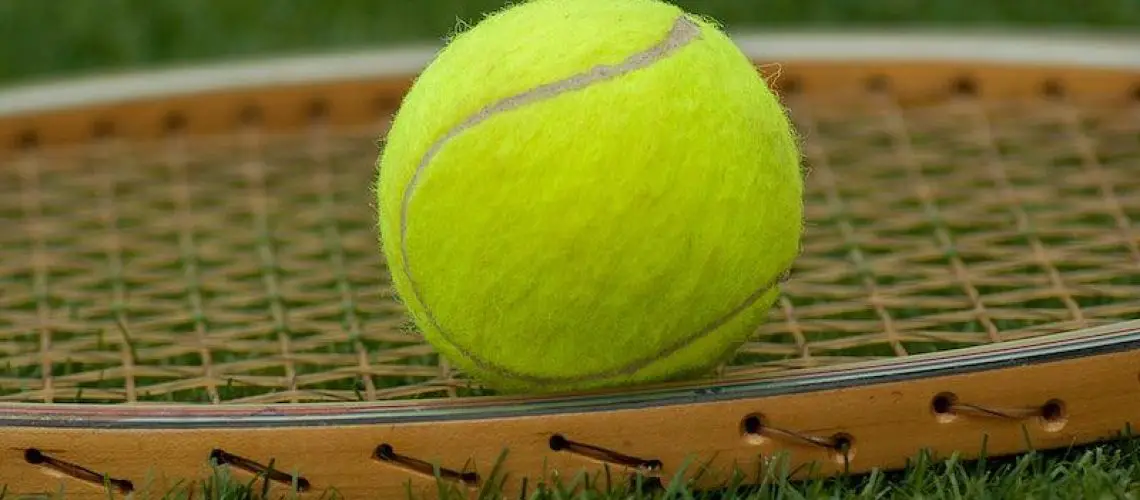We may earn money or products from the companies mentioned in this post.
Brief history of tennis balls

Tennis, a sport beloved by millions, has a rich history that dates back centuries But have you ever wondered about the humble beginnings of the tennis ball itself? Let’s take a journey through time and explore how these small but mighty spheres came into existence
Early materials used for making tennis balls
In the early days of tennis, players didn’t have the luxury of using the high-quality balls we have today Instead, they had to make do with whatever materials were available to them Can you imagine playing with a ball made from leather stuffed with human hair or wool? Yes, you heard that right! These primitive tennis balls were crafted using these unusual materials, providing players with an unpredictable and challenging experience on the court
Evolution of the modern tennis ball
As time went on and technology advanced, so did the construction of tennis balls In the 19th century, manufacturers began experimenting with different materials and designs to improve the performance and durability of these essential sporting objects Eventually, they settled on a rubber core encased in a fabric shell as the standard composition for modern tennis balls
Overview of the fuzz on a tennis ball

If you’ve ever held a tennis ball in your hand, you might have noticed its distinctive fuzzy surface That fuzz isn’t just for aesthetic purposes; it serves an important role in shaping every game of tennis played around the world
Purpose and significance of fuzz in a game
The fuzz on a tennis ball plays two crucial roles during gameplay Firstly, it helps create friction between the ball and racquet strings upon impact This friction allows players to generate spin and control over their shots, adding another layer of strategy to their gameplay
Secondly, the fuzz also affects the ball’s aerodynamics When the ball is struck, the air resistance interacts with the fuzzy surface, causing it to slow down and spin through the air in a particular manner This spin can influence how the ball bounces off the court surface, making it more challenging for opponents to anticipate and return
So next time you step onto a tennis court, take a moment to appreciate the history and craftsmanship behind those small but mighty tennis balls From their humble beginnings to their essential role in shaping every game played, these little spheres have come a long way!
Physics behind the fuzz on a tennis ball

Aerodynamics and air resistance
When it comes to the physics of a tennis ball, aerodynamics plays a crucial role in its flight The fuzz on a tennis ball affects the drag force experienced by the ball as it travels through the air This drag force is responsible for slowing down the ball and altering its trajectory
a Laminar flow versus turbulent flow:
The presence of fuzz on the surface of a tennis ball disrupts the smooth laminar flow of air around it, causing turbulence This turbulent flow creates additional drag, which can either increase or decrease depending on factors such as the speed and spin of the ball
b Maintaining optimal speed and control:
Surprisingly, despite creating extra drag, the fuzz actually helps maintain optimal speed and control during gameplay The irregular surface created by the fuzz increases friction between the ball and air molecules, providing better grip and stability in flight
Ball spin and trajectory control
The fuzz on a tennis ball also plays a significant role in generating various types of spin that players use to their advantage in matches
a Generating topspin, backspin, and sidespin:
When players strike the ball with different angles and spins, the fuzzy surface interacts with both air molecules and court surfaces to create specific types of spins Topspin occurs when players brush upwards against the fuzzy side of the ball, causing it to rotate forward rapidly upon contact with an opponent’s racket or court surface Backspin is generated when players brush downwards against the fuzzy side before impact, causing it to rotate backward upon contact Sidespin occurs when players impart lateral movement by brushing sideways against either side of the fuzzy surface
b The Magnus effect:
The fuzz on a tennis ball significantly influences the Magnus effect, which is the phenomenon responsible for the curved path of a spinning object in flight As the ball spins through the air, the turbulent flow created by its fuzzy surface interacts with the surrounding air molecules, resulting in an imbalance of pressures on opposing sides of the ball This pressure difference causes the ball to deviate from its regular trajectory, making it difficult for opponents to predict and return shots accurately
Tennis Ball Manufacturing Process & Materials

When it comes to tennis ball production, the materials used play a crucial role in determining the quality and performance of the final product Let’s dive into the different types of materials involved in making tennis balls
Types of Materials Used for Making Tennis Balls
1 Rubber Core Composition: The heart of every tennis ball lies in its rubber core This core is typically made from a combination of natural and synthetic rubber, carefully blended to achieve optimal bounce and durability on the court
2 Felt Covering (Fuzz) Production: The outer layer of a tennis ball, known as the felt covering or fuzz, is responsible for providing grip and control during gameplay Two commonly used materials for this purpose are nylon and wool fibers
a Nylon or Wool Fibers: Advantages and Disadvantages
Nylon fibers offer exceptional durability and resistance to wear, making them ideal for hard court surfaces that can be abrasive on tennis balls On the other hand, wool fibers provide superior softness and enhance spin potential, making them suitable for clay or grass courts
b Different Types of Felt Used for Various Playing Surfaces
Tennis courts come in various forms such as grass, clay, and hard court surfaces like concrete or asphalt To cater to these different playing conditions, manufacturers utilize different types of felt coverings that are specifically designed to optimize performance on each surface
Manufacturing Process
Now that we have explored the materials involved let’s take a closer look at how tennis balls are manufactured from start to finish
-
Creation of Rubber Core:
The manufacturing process begins with the creation of the rubber core Natural and synthetic rubber materials are mixed together, forming a viscous compound that is molded into spherical shapes -
Felt Application onto Rubber Cores:
Once the rubber cores are formed, they undergo a process called “fuzzing” During this stage, the cores are coated with adhesive and then wrapped tightly with layers of woven nylon or wool fibers This creates the fuzzy outer surface that gives tennis balls their distinctive texture
And there you have it! The intricate process involved in manufacturing tennis balls, from selecting the right materials to crafting them into high-quality sporting equipment Next time you step onto the court, take a moment to appreciate the craftsmanship behind those little yellow spheres that bring joy and excitement to the game of tennis
Impact of Fuzz on Player Performance & Equipment Wear

Effect on Overall Player Experience
When it comes to the game of tennis, the texture of fuzz on tennis balls plays a crucial role in enhancing the overall player experience The fuzzy surface of the ball allows for improved grip between the racket strings and the ball itself This increased friction helps players achieve better control over their shots, enabling them to execute precise serves and powerful groundstrokes
In addition to enhancing grip, fuzz also plays a vital role in reducing impact shock when hitting the ball The fuzzy texture acts as a cushion between the racket strings and the ball, absorbing some of the force upon contact This not only provides players with a more comfortable feel during gameplay but also helps minimize strain on their wrists and joints
Durability Concerns & Impact on Equipment Wear
While fuzz contributes significantly to player performance, it can have implications for equipment durability Racket strings are particularly affected by constant contact with the fuzzy surface of tennis balls Over time, this repeated friction can lead to wear and tear on the strings, causing them to lose tension and ultimately affecting shot control
Furthermore, both tennis balls and rackets have lifespan considerations due to fuzz-related factors Tennis balls gradually lose their fuzz through use, which affects their bounce and playability Similarly, rackets may experience accelerated wear when interacting with fuzzy surfaces regularly It is important for players to be aware of these factors in order to maintain optimal equipment performance
Conclusion
The impact of fuzz on player performance and equipment wear cannot be overstated in the world of tennis While providing improved grip and shock absorption for players, it also presents challenges in terms of durability concerns for racket strings and lifespan considerations for both tennis balls and rackets By understanding the significance of fuzz, players can make informed decisions to optimize their performance on the court
Useful Links

That’s Why
The Real Reason Why Tennis Balls Are Fuzzy
Fuzzy Secrects of the Tennis Ball – spyn
The answers to 4 tennis ball questions you never knew …
Definition, Examples, and Common Questions About The Ball
SPORTS: Yellow fuzz and the enduring mystery of tennis …
Why Is There Fuzz on a Tennis Ball? – The Tennis Trend
Tennis Ball
The Dangers of Tennis Balls – Sierra Veterinary Hospital
ELI5:What is the purpose of the fuzz on tennis balls?
Kong balls rule! A perfect solution for dogs who peel tennis …
11 Smart Uses for Old Tennis Balls | HowStuffWorks
Tennis ball
Review of tennis ball aerodynamics
Discover the Secrets of Tennis Ball Aerodynamics
Sport: Fuzz Ball – TIME
How to Choose a Tennis Ball
Fuzzy Balls






